自然拼读 初级教学计划
下学期小学低段英语自然拼读教学计划
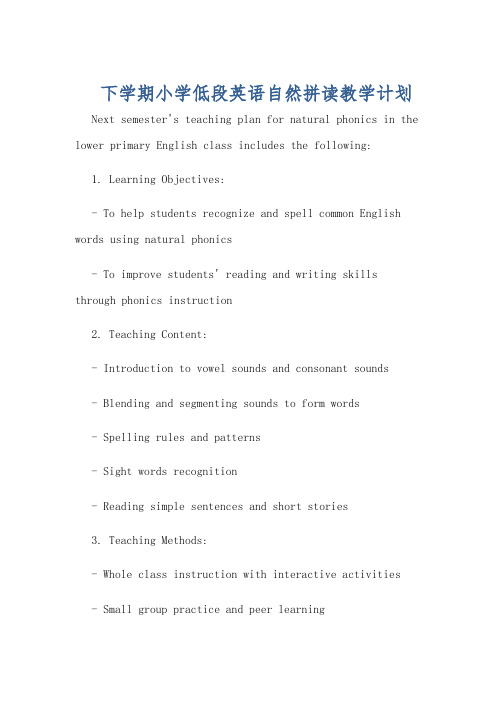
下学期小学低段英语自然拼读教学计划Next semester's teaching plan for natural phonics in the lower primary English class includes the following:1. Learning Objectives:- To help students recognize and spell common English words using natural phonics- To improve students' reading and writing skills through phonics instruction2. Teaching Content:- Introduction to vowel sounds and consonant sounds- Blending and segmenting sounds to form words- Spelling rules and patterns- Sight words recognition- Reading simple sentences and short stories3. Teaching Methods:- Whole class instruction with interactive activities - Small group practice and peer learning- Individual reading and writing exercises- Use of multimedia resources for reinforcement4. Assessment:- Weekly spelling tests- Reading comprehension quizzes- Writing assignments using phonetically spelled words - Oral presentations of short stories or passages5. Classroom Resources:- Phonics workbooks- Flashcards- Phonics games and puzzles- Audio recordings of phonetic sounds- Reading materials with phonetically spelled words6. Integration with Other Subjects:- Incorporating phonics into language arts lessons- Using phonics to support vocabulary development in science and social studies- Applying phonetic spelling in creative writing and storytelling activities下学期小学低段英语自然拼读教学计划包括以下内容:1. 学习目标:- 帮助学生通过自然拼读识别和拼写常见的英语单词- 通过拼读指导提高学生的阅读和写作能力2. 教学内容:- 元音和辅音的介绍- 合并和分割音素形成单词- 拼写规则和模式- 视觉识别常见单词- 阅读简单的句子和短篇故事3. 教学方法:- 整体教学结合互动活动- 小组练习和同学间学习- 个人阅读和写作练习- 使用多媒体资源进行强化4. 评估:- 每周的拼写测试- 阅读理解测验- 使用音标拼写的写作作业- 进行短篇故事或文章的口头展示5. 教室资源:- 拼读练习册- 字卡- 拼读游戏和拼图- 音标的录音- 含有音标拼写单词的阅读材料6. 与其他学科整合:- 将拼读融入语言艺术课程- 在科学和社会学习中使用拼读支持词汇发展- 在创意写作和讲故事活动中应用音标拼写。
小学英语自然拼读课程教学计划
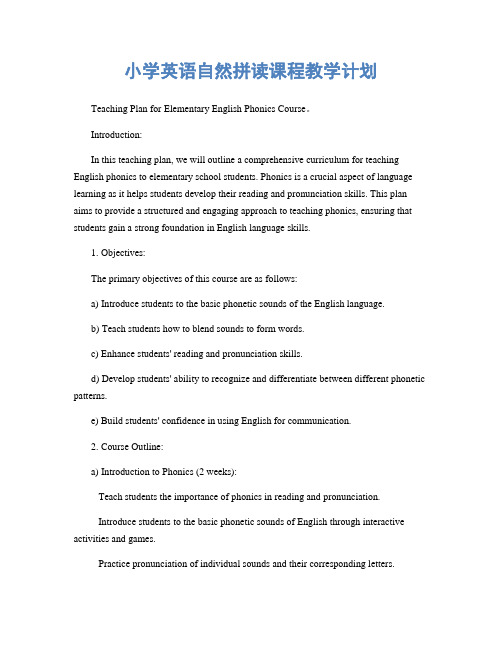
小学英语自然拼读课程教学计划Teaching Plan for Elementary English Phonics Course。
Introduction:In this teaching plan, we will outline a comprehensive curriculum for teaching English phonics to elementary school students. Phonics is a crucial aspect of language learning as it helps students develop their reading and pronunciation skills. This plan aims to provide a structured and engaging approach to teaching phonics, ensuring that students gain a strong foundation in English language skills.1. Objectives:The primary objectives of this course are as follows:a) Introduce students to the basic phonetic sounds of the English language.b) Teach students how to blend sounds to form words.c) Enhance students' reading and pronunciation skills.d) Develop students' ability to recognize and differentiate between different phonetic patterns.e) Build students' confidence in using English for communication.2. Course Outline:a) Introduction to Phonics (2 weeks):Teach students the importance of phonics in reading and pronunciation.Introduce students to the basic phonetic sounds of English through interactive activities and games.Practice pronunciation of individual sounds and their corresponding letters.b) Consonant Sounds (4 weeks):Teach students the different consonant sounds and their corresponding letters.Practice blending consonant sounds to form simple words.Reinforce learning through reading exercises and word games.c) Vowel Sounds (6 weeks):Introduce students to the different vowel sounds and their corresponding letters.Teach students the concept of long and short vowel sounds.Practice blending vowel sounds with consonants to form words.Reinforce learning through reading passages and word recognition activities.d) Consonant Blends and Digraphs (4 weeks):Teach students about consonant blends and digraphs.Practice blending consonant blends and digraphs to form words.Reinforce learning through reading exercises and word-building activities.e) Sight Words (2 weeks):Introduce students to common sight words that do not follow regular phonetic patterns.Practice recognizing and reading sight words through flashcards and word games.Reinforce learning through reading passages and comprehension activities.3. Teaching Strategies:a) Interactive Activities:Use interactive games, puzzles, and flashcards to engage students and make learning fun.Incorporate technology, such as educational apps and online resources, to enhance learning.b) Multi-sensory Approach:Use visual aids, gestures, and actions to reinforce phonetic sounds.Encourage students to listen, speak, read, and write during each lesson.c) Differentiated Instruction:Cater to the diverse learning needs of students by providing individualized support and challenges.Use a variety of teaching materials and resources to accommodate different learning styles.d) Continuous Assessment:Regularly assess students' progress through quizzes, reading assessments, and oral presentations.Provide constructive feedback to help students improve their phonics skills.4. Resources:a) Phonics textbooks and workbooks.b) Interactive online resources and educational apps.c) Flashcards, puzzles, and word games.d) Reading passages and storybooks.Conclusion:This teaching plan provides a comprehensive framework for teaching English phonics to elementary school students. By following this plan, teachers can ensure that students develop a strong foundation in phonics, which will greatly enhance their readingand pronunciation skills. The use of interactive activities, a multi-sensory approach, differentiated instruction, and continuous assessment will create an engaging and effective learning environment. With the right resources and teaching strategies, students will gain confidence in using English for communication and develop a lifelong love for reading.。
自然拼读法教案[五篇]
![自然拼读法教案[五篇]](https://img.taocdn.com/s3/m/01ec2ea2900ef12d2af90242a8956bec0975a59a.png)
自然拼读法教案[五篇]第一篇: 自然拼读法教案自然拼音法(Phonics)教案第一节:1)先来认识26个字母所代表的发音A aB bC cD dE eF fG gH h L l J j K k L l M m N n O o P p Q q R r S s T t U u V v W w X x Y y Z z 2)认识5个元音字母与21个辅音字母。
五个元音字母(a, e, i, o, u), 每个发两种音: 长音(其字母音)和短音, y不在单词开头时, 一般被看做元音字母发音——字母组合发音——单词发音层层递进, 简单易学第二节:短元音 a e i o u 的发音规律※如果一个英语单词或音节里只有一个元音, 且元音不在末尾, 这个元音一般发短音.1)短元音: a [æ]: bag cat mat map apple bat hat fan hand Stan happy 2)短元音: e [e] egg well red pen net hen bed bell best 3)短元音: i [i] lick six bib pig pin kiss ink hill 4)短元音: o [ɔ] pot ox top dog fox box lost top5)短元音: u [ʌ] sun umbrella cup bus nut gun uncle under ※y在末尾(作为元音处理):1)单音节词, 没有其他元音, y发[ai] y [ai]: my, why, fly spy sky shy cry my type dry 2)多音节词, y发[i]y [ i ] puppy dirty rainy sunny happy baby dizzy pony ey [ i ] monkey turkey jockey donkey key hockey money ※如果一个单词或音节里只有一个元音,而且元音在末尾, 这个元音一般发长音(其字母音)如: me, she,hi, go, baby, table, we e he me she we o go a baby table i hi 第三节:一个单词或音节里有两个元音时, 一般来说, 前边一个元音发长音(其字母音), 后边一个元音不发音.长元音1:Magic E(神奇的E)a-e, e-e, i-e, o-e, u-e 发音规律1)长元音: [ei]: a-e space cake snake lake plane name whale grape cage(café)2)长元音: [i:] e-e these Japanese Chinese 3)长元音: [ai] i-e bite five nine kite mine nice ride side 4)长元音: [əu] o-e rose nose rope note pose home rode those 5)长元音: [ju:] u-e tube cube June cute huge 第四节:长元音2: ai ay ee ea ie igh oa ow oe ui ue发音规律 ai [ei] : paint pain tail rain nail maid jail rail ay[ei]:ray say bay way hay lay may payee[i:] : bee peel reeds eel see teeth jeep feet ea[i:] : peanut meat eagle sea leaf pea peach tea ie[ai] : tie pie lie die igh[ai]: ight sight night tight light sigh fight high oa [ou] : coat toast road boat coal goat toad soap ow [ou] :yellow pillow row rainbow bowl window hollow low oe[ou]: doe, hoe, toe ui [ju:] : suit juice fruit ue[ju:] : blue glue sue 第五节带元音的特殊读法or ar ur ir er ear er发音规律※or[ɔ:]:pork porch horse horn corn fork morning ※or[ə:]:work worm world ar[a:]:arm card arm car cart park garden farm ur[ə:]:hurt turkey turtle surfing nurse purse fur ir[ə:]:birthday circus dirty bird circle dirt girl er[ə:]:mermaid term her nerd serve ear[ə:]:learn earn earth heard er[ə]:sister brother marker rooster under mother winter 第六节带元音的特殊读法单元音au aw oo ea all发音规律au[ɔ:]:august sausage sauce naughty autumn applause aw[ɔ:]:saw paw draw strawberry straw lawn oo[u:]:moon zoo roof rooster spoon room boots food oo[u]:book cookie woods wool hook look foot cook ea[e]:head sweater sweat leather feather lead all[ɔ:]: wall fall ball call tall第七节带元音的特殊读法双元音ou ow oi oy ew 发音规律ou [au] mouth out house count shout mouse ow [au]:clown cow owl towel flower tower crown brown oi [ɔi]:coin oil point noise poisoncoil boil soil oy [ɔi]:oyster boy soy toyew [ju:]:new nephew newspaper few dew view第八节带元音的特殊读法双元音 are air ire ear eer 发音规律 are [ɛə] : care share scare dare air[ɛə]: hair air repair ire [aiə]: fire wire ear[iə]: near tear dear clear year hear eer[iə] : deer beer cheers engineer pioneer volunteer 第九节辅音字母组合构成的一种单音1.ch sh wh ph th kn wr 发音规律ch[ʧ] :beach lunch cheese bench chair cherry church chicken sh[ʃ]:sheep shirt ship fish shoes dish pushwh[w]:wheel white whale wheat wheel whisper whip whistle ph [f]:elephant photo telephone th[ð]:brother feather leather father mother(舌头放在上下牙之间, 然后迅速收回, 此音一般在单词的中间, 后接元音)th[θ]:thumb bathmat three thirsty mouth teeth thief bath 舌头放在上下牙之间, 不动, 让其留从舌尖滑过, 此音一般放在单词的开头或最后, 属于气音。
初级英语自然拼读法phonics教学教案

初级英语自然拼读法phonics教学教案一、教学目标- 帮助学生掌握英语自然拼读法的基本原则和技巧- 培养学生对英语读音的敏感性和准确性- 提高学生的英语发音和拼写能力二、教学内容1. 字母的发音和拼写规则2. 发音和拼写的规则与例外3. 单词的拼读技巧和方法4. 练和巩固拼读技巧的活动三、教学过程1. 导入:通过播放英语儿歌或有关字母发音的视频,引发学生对英语自然拼读法的兴趣和好奇心。
2. 教学主体:- 按照字母表的顺序,依次教授每个字母的发音和拼写规则,并指导学生正确发音和书写。
- 介绍发音和拼写的一些规则和例外,比如"silent e"、双元音字母组合等。
- 教授一些常见的拼读技巧和方法,例如辅音字母的发音,元音字母的发音等。
- 利用练和游戏的形式,帮助学生巩固所学的拼读技巧和规则。
3. 巩固练:通过阅读短文、听写、拼读游戏等方式进行巩固练,提高学生的拼读和发音能力。
4. 总结:回顾所学的发音和拼写规则,总结自然拼读法的优点和应用范围。
四、教学评价和反馈1. 通过课堂练和作业,评价学生对发音和拼读规则的掌握程度。
2. 鼓励学生相互评价和反馈,互相促进研究进步。
3. 及时提供反馈和指导,帮助学生纠正错误和改进发音和拼读能力。
五、教学资源- 英语儿歌或有关字母发音的视频- 教材和相关练册- 教学投影仪和音响设备- 课堂练和游戏所需的道具和材料六、教学反思及改进1. 教师在讲解发音和拼写规则时要简明扼要,避免过多的专业术语和复杂的解释。
2. 练和游戏要选择有趣和有效的形式,以激发学生的研究兴趣和积极性。
3. 鼓励学生多加练和运用所学的拼读技巧,不断提升自己的能力。
该教学教案旨在通过自然拼读法来教授初级英语学习者发音和拼读的基本技巧。
通过系统的教学过程和巩固练习,帮助学生掌握英语自然拼读法的基本原则和技巧,并在实践中提高学生的发音和拼写能力。
初级英语自然拼读法Phonics教学教案

初级英语自然拼读法Phonics教学教案目标/Objectives
本教学教案的目标是帮助初学英语的学生掌握自然拼读法Phonics。
通过本课程的研究,学生将能够:
- 理解基本的英语单词及其发音规则
- 通过正确的发音技巧自信地阅读英语文本
- 尝试用英语口语交流
教学材料/Materials
- PPT
- 字卡/Flashcards
- 音频播放设备
教学过程/Procedures
步骤一:引入/Introduction(5分钟)
- 向学生介绍本课程的主题:自然拼音Phonics - 演示一个英文字母及其发音规则
- 准备一些例子,让学生听音并尝试跟读
步骤二:主体课程-字母和音标(30分钟)
- 介绍英文字母表
- 研究元音及其发音规则
- 研究辅音及其发音规则
- 用发音规则组合字母,介绍词汇
步骤三:阅读练(15分钟)
- 分发字卡/Flashcards
- 学生互相读出卡片上的单词
- 老师提供反馈和指导
步骤四:语音训练(15分钟)
- 播放录音,让学生听音并跟读
- 让学生尝试用所学发音技巧快速阅读一段英文文本- 先让学生练单词发音,然后逐渐练短语和句子
步骤五:游戏练(15分钟)
- 按学生层次分组,分别进行比赛
- 让学生自由组合所学单词和短语,用时限来进行比赛- 老师提供反馈和指导
结束/Conclusion
- 向学生总结所学内容
- 回答问题并解决学生的困惑
参考文献/Reference
无。
自然拼读法完整教案版
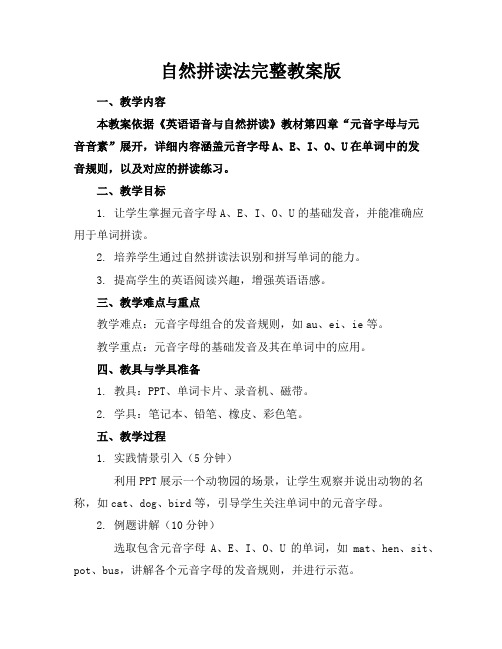
自然拼读法完整教案版一、教学内容本教案依据《英语语音与自然拼读》教材第四章“元音字母与元音音素”展开,详细内容涵盖元音字母A、E、I、O、U在单词中的发音规则,以及对应的拼读练习。
二、教学目标1. 让学生掌握元音字母A、E、I、O、U的基础发音,并能准确应用于单词拼读。
2. 培养学生通过自然拼读法识别和拼写单词的能力。
3. 提高学生的英语阅读兴趣,增强英语语感。
三、教学难点与重点教学难点:元音字母组合的发音规则,如au、ei、ie等。
教学重点:元音字母的基础发音及其在单词中的应用。
四、教具与学具准备1. 教具:PPT、单词卡片、录音机、磁带。
2. 学具:笔记本、铅笔、橡皮、彩色笔。
五、教学过程1. 实践情景引入(5分钟)利用PPT展示一个动物园的场景,让学生观察并说出动物的名称,如cat、dog、bird等,引导学生关注单词中的元音字母。
2. 例题讲解(10分钟)选取包含元音字母A、E、I、O、U的单词,如mat、hen、sit、pot、bus,讲解各个元音字母的发音规则,并进行示范。
3. 随堂练习(10分钟)让学生根据所学发音规则,拼读和拼写单词,如:cat(/k æ t/)、bed(/b ɛ d/)等。
4. 小组讨论(5分钟)学生分成小组,讨论如何运用自然拼读法识别新单词。
6. 课堂游戏(5分钟)设计一个单词拼读游戏,让学生在游戏中巩固所学知识。
六、板书设计1. 自然拼读法——元音字母发音规则2. 内容:A:/æ/,如:cat、batE:/ɛ/,如:bed、redI:/ɪ/,如:sit、hillO:/ɒ/,如:pot、dogU:/ʌ/,如:bus、cup七、作业设计1. 作业题目:(3)结合自然拼读法,阅读一篇短文,标注出生词并尝试拼读。
2. 答案:(1)cat、bed、sit、pot、bus。
(2)fat(/f æ t/)、leg(/l ɛ g/)、pip(/p ɪ p/)、dot(/d ɒ t/)、sun(/s ʌ n/)。
初中自然拼读法教案

初中自然拼读法教案一、教学目标:1. 让学生掌握自然拼读法的基本原理和技巧。
2. 培养学生准确、快速地拼读单词的能力。
3. 提高学生词汇量和阅读理解能力。
二、教学内容:1. 自然拼读法的基本概念。
2. 音素和音标的概念。
3. 拼读规则和常见字母组合的发音。
4. 实践练习:单词拼读、句子拼读、短文阅读。
三、教学重点与难点:1. 重点:让学生掌握自然拼读法,能够准确、快速地拼读单词。
2. 难点:音素和音标的识别,以及拼读规则和字母组合的发音。
四、教学方法:1. 讲授法:讲解自然拼读法的基本原理和技巧。
2. 示范法:教师示范拼读单词和句子。
3. 练习法:学生进行单词拼读、句子拼读和短文阅读练习。
4. 互动法:学生分组练习,相互检查和纠正发音。
五、教学步骤:1. 导入:介绍自然拼读法的概念,激发学生兴趣。
2. 讲解:讲解音素、音标和拼读规则,举例说明。
3. 示范:教师示范拼读单词和句子。
4. 练习:学生进行单词拼读、句子拼读练习。
5. 互动:学生分组练习,相互检查和纠正发音。
6. 拓展:引导学生运用自然拼读法阅读短文,提高阅读理解能力。
7. 总结:对本节课内容进行总结,强调重点和难点。
六、课后作业:1. 复习本节课所学内容,巩固记忆。
2. 完成课后练习题,提高拼读能力。
3. 自主阅读一篇英文文章,运用自然拼读法提高阅读速度。
七、教学评价:1. 课后作业完成情况:检查学生对课堂内容的掌握程度。
2. 课堂表现:观察学生在课堂上的参与程度、发音准确性以及拼读速度。
3. 阅读测试:定期进行阅读测试,评估学生的阅读理解能力和词汇量。
通过本节课的教学,使学生掌握自然拼读法,提高他们的英语学习兴趣和自信心,为今后的英语学习打下坚实的基础。
自然拼读教学计划
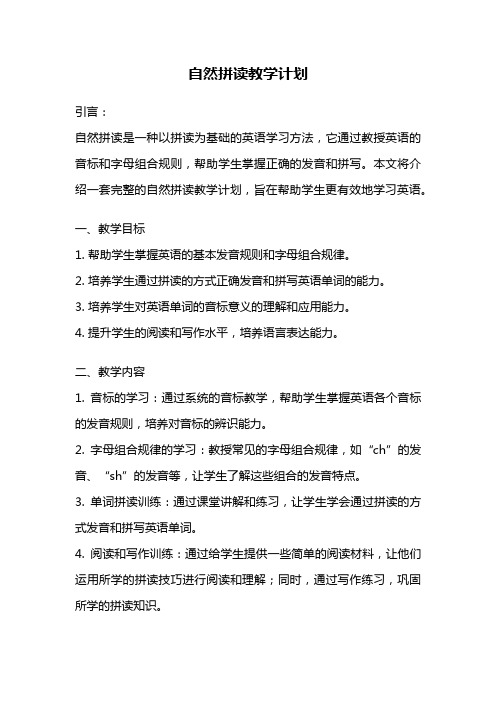
自然拼读教学计划引言:自然拼读是一种以拼读为基础的英语学习方法,它通过教授英语的音标和字母组合规则,帮助学生掌握正确的发音和拼写。
本文将介绍一套完整的自然拼读教学计划,旨在帮助学生更有效地学习英语。
一、教学目标1. 帮助学生掌握英语的基本发音规则和字母组合规律。
2. 培养学生通过拼读的方式正确发音和拼写英语单词的能力。
3. 培养学生对英语单词的音标意义的理解和应用能力。
4. 提升学生的阅读和写作水平,培养语言表达能力。
二、教学内容1. 音标的学习:通过系统的音标教学,帮助学生掌握英语各个音标的发音规则,培养对音标的辨识能力。
2. 字母组合规律的学习:教授常见的字母组合规律,如“ch”的发音、“sh”的发音等,让学生了解这些组合的发音特点。
3. 单词拼读训练:通过课堂讲解和练习,让学生学会通过拼读的方式发音和拼写英语单词。
4. 阅读和写作训练:通过给学生提供一些简单的阅读材料,让他们运用所学的拼读技巧进行阅读和理解;同时,通过写作练习,巩固所学的拼读知识。
三、教学方法1. 示范法:教师通过示范正确的发音和拼读方法,让学生模仿并掌握正确的技巧。
2. 练习法:通过大量的练习,让学生巩固所学的拼读知识,并提高拼读的准确性和流利度。
3. 游戏法:通过一些有趣的拼读游戏,激发学生的学习兴趣,增强记忆效果。
四、教学步骤1. 音标学习阶段:(1)教授元音音标的发音规则,如/a/的发音。
(2)教授辅音音标的发音规则,如/b/的发音。
(3)练习音标的发音,让学生熟练掌握。
2. 字母组合规律学习阶段:(1)教授常见的字母组合规律,如“ch”的发音。
(2)让学生通过练习掌握字母组合的发音规则。
3. 单词拼读训练阶段:(1)教授一些常见的英语单词的拼读方法,如“cat”的拼读。
(2)让学生通过课堂练习巩固所学的拼读知识。
4. 阅读和写作训练阶段:(1)提供一些简单的阅读材料,让学生通过拼读的方式进行阅读和理解。
(2)通过写作练习,巩固所学的拼读知识,并提高语言表达能力。
自然拼读教学计划
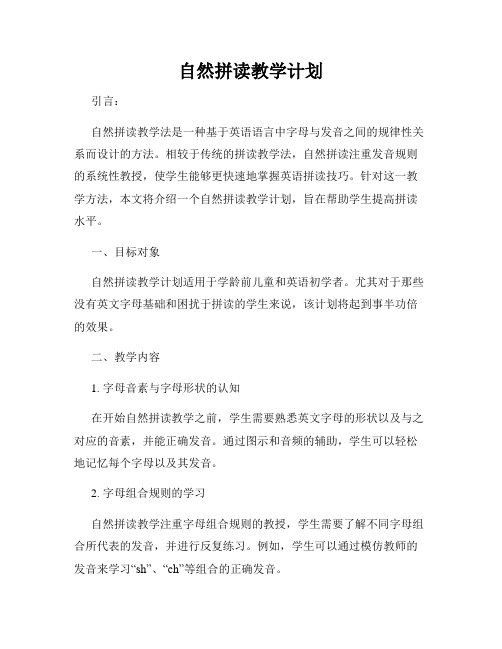
自然拼读教学计划引言:自然拼读教学法是一种基于英语语言中字母与发音之间的规律性关系而设计的方法。
相较于传统的拼读教学法,自然拼读注重发音规则的系统性教授,使学生能够更快速地掌握英语拼读技巧。
针对这一教学方法,本文将介绍一个自然拼读教学计划,旨在帮助学生提高拼读水平。
一、目标对象自然拼读教学计划适用于学龄前儿童和英语初学者。
尤其对于那些没有英文字母基础和困扰于拼读的学生来说,该计划将起到事半功倍的效果。
二、教学内容1. 字母音素与字母形状的认知在开始自然拼读教学之前,学生需要熟悉英文字母的形状以及与之对应的音素,并能正确发音。
通过图示和音频的辅助,学生可以轻松地记忆每个字母以及其发音。
2. 字母组合规则的学习自然拼读教学注重字母组合规则的教授,学生需要了解不同字母组合所代表的发音,并进行反复练习。
例如,学生可以通过模仿教师的发音来学习“sh”、“ch”等组合的正确发音。
3. 基于音节划分的拼读自然拼读通过音节划分来帮助学生理解单词的发音规律。
在教学过程中,教师可以引导学生注意单词中的音节,并模仿正确的发音。
4. 音标的学习音标是自然拼读教学中重要的一环。
学生需要了解各种音标的含义,并能够准确地根据音标发声。
通过图片和实物的搭配,学生可以更好地理解音标的用法。
三、教学方法1. 游戏化教学在自然拼读教学中,游戏化教学是一种常见的方法。
教师可以设计各种与字母和音素相关的游戏,激发学生的学习兴趣,并通过游戏达到提高拼读能力的目的。
2. 图像和音频的结合通过图像和音频的结合,学生可以更加直观地了解字母的形状和发音。
教师可以为学生准备配有字母图像和对应发音的音频,使学生能够通过视听的方式进行学习。
3. 反复练习与巩固自然拼读需要不断的反复练习来巩固学习成果。
教师可以设置各种练习题,如拼写、听音辨字等,帮助学生反复巩固所学的拼读技巧。
四、教学评估教学评估旨在了解学生对自然拼读教学的掌握情况,并帮助教师及时调整教学策略。
自然拼读法教案设计

自然拼读法教案设计一、教学目标1.让学生掌握自然拼读法的原理和方法,提高英语单词拼读和记忆能力。
2.培养学生自主学习和合作学习的能力,提高英语学习兴趣。
3.帮助学生积累常用词汇,扩大词汇量,为英语阅读和写作打下基础。
二、教学内容1.自然拼读法的原理和规则2.元音字母和辅音字母的发音规律3.单词拼读和记忆技巧4.拼读练习和游戏活动三、教学步骤1.导入(5分钟)利用图片、歌曲或故事等引入本节课的主题,激发学生的学习兴趣。
2.讲解自然拼读法的原理和规则(10分钟)详细讲解自然拼读法的原理,使学生了解英语单词拼读的基本规律。
3.元音字母和辅音字母的发音规律(10分钟)分别介绍元音字母和辅音字母的发音规律,举例说明,帮助学生理解和记忆。
4.单词拼读和记忆技巧(10分钟)分享单词拼读和记忆技巧,如:音节划分、字母组合等。
5.拼读练习和游戏活动(15分钟)设计各种拼读练习和游戏活动,让学生在轻松愉快的氛围中巩固所学知识。
6.总结与布置作业(5分钟)总结本节课的主要内容,布置作业,要求学生课后进行自主学习和复习。
四、教学评价1.课堂参与度:观察学生在课堂上的表现,如:提问、回答问题、参与讨论等。
2.拼读能力:检查学生对自然拼读法的掌握程度,如:单词拼读、拼写等。
3.作业完成情况:评估学生课后作业的完成质量,如:作业的正确率、书写等。
4.学习兴趣:了解学生对自然拼读法的学习兴趣,如:课堂表现、课后反馈等。
五、教学资源1.教材:英语课本、自然拼读教材等。
2.教学工具:多媒体设备、白板、卡片等。
3.网络资源:英语学习网站、在线课程、教学视频等。
4.辅助材料:单词卡片、拼读练习册、游戏道具等。
六、教学建议1.注重个体差异,因材施教,关注学生的学习需求和兴趣。
2.创设丰富的语言环境,让学生在实际语境中运用自然拼读法。
3.鼓励学生积极参与课堂活动,提高学习积极性。
4.定期进行教学评价,及时了解学生的学习情况,调整教学策略。
自然拼读法教案[]
![自然拼读法教案[]](https://img.taocdn.com/s3/m/20f26f06bf23482fb4daa58da0116c175f0e1ed6.png)
自然拼读法教案——小学英语语音教学一、教学目标1.让学生掌握26个字母的基本发音。
2.培养学生运用自然拼读法拼读单词的能力。
3.提高学生英语阅读和口语表达能力。
二、教学内容1.26个字母的基本发音。
2.自然拼读法的基本规则。
3.实践练习:拼读单词、句子。
三、教学重点与难点1.教学重点:26个字母的基本发音,自然拼读法的基本规则。
2.教学难点:字母组合的发音规律,长单词的拼读。
四、教学步骤第一课时:字母发音教学1.导入师:同学们,大家好!今天我们要学习一种新的英语学习方法——自然拼读法。
我们来学习26个字母的基本发音。
2.教学字母发音师:我们先来学习字母A的发音。
请大家跟我读:[ei]。
A的发音就像“爱”的发音。
(1)师:我们学习字母B的发音。
请大家跟我读:[biː]。
B的发音就像“比”的发音。
(2)师:现在,我们来学习字母C的发音。
请大家跟我读:[siː]。
C的发音就像“西”的发音。
(以此类推,教完所有字母的发音)3.练习字母发音师:同学们,我们已经学习了26个字母的发音,现在我们来练习一下。
我会说出一个字母,请大家快速准确地读出它的发音。
(1)师:A生:[ei](2)师:B生:[biː](以此类推,练习所有字母的发音)第二课时:自然拼读法教学1.导入师:上一节课,我们学习了26个字母的基本发音。
今天,我们将学习如何运用自然拼读法来拼读单词。
2.教学自然拼读法师:自然拼读法就是根据字母的发音,将单词拆分成音节,然后逐个音节拼读出来。
(1)师:我们先来学习一个简单的单词——cat。
这个单词由三个字母组成,分别是c、a、t。
我们先读出每个字母的发音,然后拼在一起。
生:[k][æ][t]师:拼读出来就是[kaet]。
(2)师:我们再来学习一个单词——dog。
这个单词也由三个字母组成,分别是d、o、g。
我们先读出每个字母的发音,然后拼在一起。
生:[d][ɒ][g]师:拼读出来就是[dɒg]。
(以此类推,教完一些简单的单词)3.练习自然拼读法师:同学们,我们已经学习了自然拼读法,现在我们来练习一下。
自然拼读教学工作计划

一、前言自然拼读(Phonics)是一种以英语字母及字母组合的发音规律为基础,帮助学习者通过拼读规则来认读和拼写单词的方法。
在我国,自然拼读作为一种有效的英语学习方法,越来越受到广大教师的重视。
本教学计划旨在制定一套系统、科学、实用的自然拼读教学方法,以提高学生的英语阅读和拼写能力。
二、教学目标1. 让学生掌握26个英文字母的发音和字母组合的发音规律;2. 培养学生自主拼读单词的能力,提高阅读速度和准确性;3. 帮助学生纠正发音,提高英语口语水平;4. 激发学生学习英语的兴趣,培养学生的英语学习自信心。
三、教学内容1. 字母及字母组合的发音规律;2. 单词拼读技巧;3. 常见词拼读;4. 阅读理解技巧;5. 写作技巧。
四、教学安排1. 教学阶段划分:(1)初级阶段:学习26个英文字母的发音和字母组合的发音规律;(2)中级阶段:学习单词拼读技巧和常见词拼读;(3)高级阶段:提高阅读理解技巧和写作技巧。
2. 教学课时分配:(1)初级阶段:每周2课时;(2)中级阶段:每周2课时;(3)高级阶段:每周2课时。
3. 教学方法:(1)情景教学法:通过图片、视频、故事等形式,创设真实语境,帮助学生理解单词含义;(2)游戏教学法:设计趣味性强的游戏,激发学生学习兴趣,提高学习效率;(3)任务驱动法:布置实际任务,让学生在完成任务的过程中,巩固所学知识;(4)小组合作学习法:鼓励学生互相帮助,共同进步。
五、教学评价1. 课堂表现:观察学生在课堂上的参与度、积极性、合作精神等;2. 作业完成情况:检查学生作业的准确性和完成度;3. 定期测试:通过听写、阅读理解、写作等测试,评估学生的学习成果。
六、教学总结1. 定期总结教学效果,调整教学策略;2. 关注学生的学习需求,提供个性化指导;3. 与家长保持沟通,共同关注学生的英语学习情况;4. 不断丰富教学内容,提高教学质量。
通过以上教学计划,相信学生在自然拼读的学习过程中,能够取得显著的进步,为今后的英语学习打下坚实的基础。
自然拼读教案完整版

自然拼读教案完整版一、教学内容本节课选自《新概念英语》第一册第五章,详细内容为自然拼读法的基本规则和单词拼读练习。
主要涉及元音字母a、e、i、o、u在单词中的发音规律以及常见字母组合的发音。
二、教学目标1. 让学生掌握自然拼读法的基本规则,提高单词拼读能力。
2. 培养学生自主拼读单词的能力,增强英语学习的自信心。
3. 引导学生通过自然拼读法记忆单词,提高词汇量。
三、教学难点与重点1. 教学难点:元音字母组合的发音规律,如ai、ay、ee等。
2. 教学重点:自然拼读法的基本规则及其在单词中的应用。
四、教具与学具准备1. 教具:PPT、单词卡片、录音机、磁带。
2. 学具:笔记本、铅笔、橡皮。
五、教学过程1. 导入:通过一个实践情景引入,如购物场景,让学生尝试读出场景中的单词。
2. 新课内容:讲解自然拼读法的基本规则,以单词cat、bed、pig、dog为例,引导学生发现元音字母的发音规律。
3. 例题讲解:选取几个典型单词,如like、play、see、you,讲解元音字母组合的发音规律。
4. 随堂练习:让学生分组进行单词拼读练习,教师巡回指导。
6. 应用:让学生用自然拼读法读出一些新单词,如house、school、family等。
六、板书设计1. 自然拼读法基本规则2. 元音字母发音规律3. 常见字母组合发音规律4. 课堂练习单词七、作业设计a) cat ( ) b) bed ( ) c) like ( ) d) family ( )2. 答案:a) 猫 b) 床 c) 喜欢 d) 家庭八、课后反思及拓展延伸1. 课后反思:本节课学生对自然拼读法的掌握程度,以及课堂练习的参与度。
2. 拓展延伸:鼓励学生用自然拼读法阅读英语绘本,提高英语阅读兴趣和词汇量。
重点和难点解析1. 教学内容的选取与组织2. 教学目标的设定3. 教学难点与重点的识别4. 教学过程的实施5. 板书设计6. 作业设计与答案提供7. 课后反思与拓展延伸详细补充和说明:一、教学内容的选取与组织教学内容应紧密结合学生的实际水平和学习需求,选择合适的教材和章节。
自然拼读全套学习计划

自然拼读全套学习计划第一阶段:音节拆分在学习自然拼读的第一阶段,我们将帮助学生了解英语的音节结构和如何拆分音节。
通过讲解和练习,学生可以逐渐掌握如何正确拆分英语单词的音节。
在这个阶段,老师可以用一些简单易记的单词和句子来进行教学,比如cat、dog、apple等单词,让学生逐渐熟悉英语的音节结构。
第二阶段:单词拼读在掌握了音节拆分的基础上,学生可以开始学习如何用音节拼读单词。
老师可以逐步教授一些单词的拼读规则,比如元音、子音、重读音节等规则,并让学生通过练习来巩固所学内容。
同时,老师也可以带领学生进行一些拼读游戏,让他们在趣味中提高自然拼读技能。
第三阶段:阅读训练在学习了单词拼读的基础上,学生可以开始进行阅读训练。
老师可以选择一些适合学生水平的文章或故事,让他们用自然拼读的方法来阅读,并逐步提高阅读速度和理解能力。
同时,老师也可以组织学生进行一些阅读比赛,激发学生的学习兴趣,提高他们的学习动力。
第四阶段:语音表达在学习了自然拼读的基础上,学生可以开始进行语音表达训练。
老师可以让学生通过朗读练习,提高英语的语音表达能力。
同时,老师还可以组织学生进行一些口语交流活动,让他们在实际情境中应用所学的自然拼读知识,提高他们的口语表达能力。
以上是自然拼读的全套学习计划,通过这些阶段的学习,我们相信学生可以更好地掌握自然拼读的方法,提高他们的英语发音和阅读能力。
同时,我们也鼓励学生在学习过程中多多练习,不断提高自己的能力,用自然拼读的方法来更好地理解和使用英语。
希望学生能够在自然拼读的学习中取得更大的进步,成为优秀的英语学习者。
开学英语自然拼读教案初中

教案标题:初中英语自然拼读教学一、教学目标:1. 让学生掌握英语字母表及字母组合的发音规则。
2. 培养学生正确拼读单词的能力,提高学生的词汇量。
3. 通过对单词的拼读训练,提高学生的阅读理解能力。
二、教学内容:1. 英语字母表及字母组合的发音规则。
2. 常用单词的拼读练习。
3. 简单的阅读理解练习。
三、教学方法:1. 采用互动式教学法,让学生积极参与课堂活动,提高学生的学习兴趣。
2. 采用分组讨论法,培养学生的团队协作能力。
3. 运用任务型教学法,让学生在完成任务的过程中,巩固所学知识。
四、教学步骤:Step 1: 引入新课1. 教师通过图片或实物,引入本节课的主题。
2. 引导学生回顾已学的字母及字母组合的发音规则。
Step 2: 讲解与示范1. 教师讲解本节课要学习的字母组合的发音规则。
2. 教师示范读音,让学生跟随模仿。
Step 3: 拼读练习1. 教师给出含有本节课字母组合的单词,让学生拼读。
2. 学生相互练习,教师巡回指导。
Step 4: 阅读理解1. 教师给出一个简短的阅读材料,要求学生根据所学知识,正确拼读单词,理解文章内容。
2. 学生独立完成阅读,教师提问,检查学生的理解程度。
Step 5: 总结与反馈1. 教师对本节课的内容进行总结,强调重点。
2. 学生反馈学习情况,提出疑问。
五、课后作业:1. 复习本节课所学字母组合的发音规则。
2. 完成课后练习,提高拼读能力。
3. 积累词汇,扩大词汇量。
通过以上教学设计,旨在帮助学生掌握英语自然拼读方法,提高学生的英语听说读写能力,为今后的英语学习打下坚实基础。
自然拼音教学工作计划小学
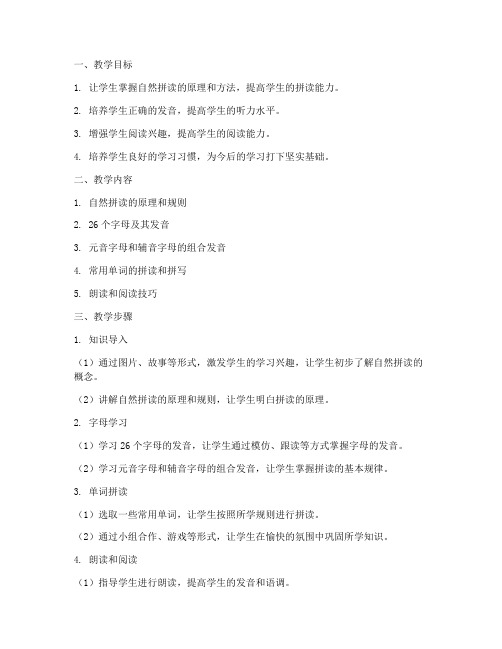
一、教学目标1. 让学生掌握自然拼读的原理和方法,提高学生的拼读能力。
2. 培养学生正确的发音,提高学生的听力水平。
3. 增强学生阅读兴趣,提高学生的阅读能力。
4. 培养学生良好的学习习惯,为今后的学习打下坚实基础。
二、教学内容1. 自然拼读的原理和规则2. 26个字母及其发音3. 元音字母和辅音字母的组合发音4. 常用单词的拼读和拼写5. 朗读和阅读技巧三、教学步骤1. 知识导入(1)通过图片、故事等形式,激发学生的学习兴趣,让学生初步了解自然拼读的概念。
(2)讲解自然拼读的原理和规则,让学生明白拼读的原理。
2. 字母学习(1)学习26个字母的发音,让学生通过模仿、跟读等方式掌握字母的发音。
(2)学习元音字母和辅音字母的组合发音,让学生掌握拼读的基本规律。
3. 单词拼读(1)选取一些常用单词,让学生按照所学规则进行拼读。
(2)通过小组合作、游戏等形式,让学生在愉快的氛围中巩固所学知识。
4. 朗读和阅读(1)指导学生进行朗读,提高学生的发音和语调。
(2)推荐一些适合学生阅读的书籍,培养学生的阅读兴趣。
5. 评价与反馈(1)定期进行自然拼读测试,了解学生的学习情况。
(2)针对学生的不足,给予个别辅导和指导。
四、教学评价1. 学生对自然拼读的掌握程度,包括字母发音、拼读规则、单词拼写等。
2. 学生的阅读兴趣和阅读能力,包括朗读、阅读速度、理解能力等。
3. 学生的学习习惯,包括课堂纪律、作业完成情况等。
五、教学进度安排1. 第1周:介绍自然拼读的概念,讲解自然拼读的原理和规则。
2. 第2-4周:学习26个字母及其发音,掌握元音字母和辅音字母的组合发音。
3. 第5-8周:学习常用单词的拼读和拼写,提高学生的拼读能力。
4. 第9-12周:进行朗读和阅读训练,培养学生的阅读兴趣。
5. 第13-16周:进行自然拼读测试,评价学生的学习成果。
六、教学资源1. 自然拼读教材2. 自然拼读辅助工具(如拼读卡片、拼读游戏等)3. 适合学生阅读的书籍4. 课堂记录本通过以上教学计划,我们相信学生在自然拼音的学习过程中,能够掌握拼读技巧,提高阅读能力,为今后的学习打下坚实基础。
自然拼读教学计划

引言概述:自然拼读教学计划(二)旨在进一步探索和优化自然拼读教学方法,为学生提供更全面、系统的拼读教育。
本文将介绍该教学计划的背景和目的,并详细阐述五个主要内容:词汇拓展、文字组合规则、语音规律、语法运用和阅读技巧。
通过这些内容的深入讲解和实践指导,希望能够提高学生的拼读能力和阅读理解水平。
正文内容:1.词汇拓展1.1充实词汇库:引导学生积极拓展词汇量,提供丰富的语言素材。
1.2单词记忆技巧:教授有效的单词记忆方法,如联想法、词根词缀法等,帮助学生更好地掌握和记忆词汇。
1.3同义词辨析:引导学生学会辨析同义词,在实际运用中灵活运用,提高语言表达的丰富性。
2.文字组合规则2.1字母规律:解析字母间的组合规律,例如辅音和元音的组合等,帮助学生理解字母在单词中的运用方法。
2.2音标标注:教授音标的基本知识和标注方法,帮助学生正确地拼读单词并提高发音准确度。
2.3音位分析:通过分析音位的构成和变化,帮助学生掌握单词的拼读和发音规则。
3.语音规律3.1重读规律:介绍单词中的重读规律,如单音节词、双音节词和多音节词的重读规则,帮助学生正确把握单词的读音。
3.2连读规律:讲解连续语音中的连读现象,如辅音连读和元音连读,提供相关练习,提高学生的听力理解能力。
3.3语调规律:指导学生理解语句的语调变化,如升调、降调和平调等,帮助学生提高口语表达的自然流畅度。
4.语法运用4.1词类学习:对名词、动词、形容词等词类进行深入剖析,教导学生识别和运用不同词类的方法。
4.2句式拓展:引导学生学习各种句式结构,如简单句、复合句和复杂句等,提高语言表达的多样性。
4.3时态语态:系统讲解英语的时态和语态,帮助学生正确地运用各种时态和语态,提高语言交际的准确性。
5.阅读技巧5.1阅读策略:教授学生阅读的基本策略,如快速阅读、扫读和精读等,培养学生的阅读技巧和速度。
5.2阅读理解:指导学生有效理解阅读材料,包括主旨理解、细节理解和推理推断等,提高学生的阅读理解能力。
小学初中自然拼读教案模板

教案标题:小学初中自然拼读教学课时安排:2课时(90分钟)教学目标:1. 学生能够理解自然拼读的概念,掌握音素和字母之间的关系。
2. 学生能够正确发音,拼读和拼写单词。
3. 学生能够通过自然拼读技巧提高阅读理解能力。
教学准备:1. 教学PPT或黑板2. 自然拼读教材或单词卡片3. 学生作业本教学过程:第一课时:一、导入(10分钟)1. 教师通过简单的英语问候,引起学生的兴趣。
2. 向学生介绍自然拼读的概念和重要性。
二、讲解(20分钟)1. 教师讲解音素和字母之间的关系,引导学生理解自然拼读的基本原理。
2. 举例说明常见字母的发音规则,如元音字母a, e, i, o, u的发音。
3. 引导学生通过观察和练习,发现字母组合的发音规律,如sh, ch, th等。
三、练习(20分钟)1. 教师组织学生进行小组活动,互相练习发音和拼读单词。
2. 教师选取一些简单的单词,让学生尝试用自然拼读技巧进行拼读和拼写。
四、总结(10分钟)1. 教师引导学生回顾本节课所学内容,巩固知识点。
2. 学生提问,教师解答。
第二课时:一、复习(10分钟)1. 教师通过复习上节课的内容,检查学生对自然拼读的掌握程度。
2. 学生进行小组活动,互相测试发音和拼读单词。
二、讲解(20分钟)1. 教师讲解一些复杂字母组合的发音规则,如str, consonant blend等。
2. 举例说明,让学生通过观察和练习,发现更多发音规律。
三、练习(20分钟)1. 教师组织学生进行小组活动,互相练习发音和拼读单词。
2. 教师选取一些复杂的单词,让学生尝试用自然拼读技巧进行拼读和拼写。
四、总结(10分钟)1. 教师引导学生回顾本节课所学内容,巩固知识点。
2. 学生提问,教师解答。
五、作业布置(5分钟)1. 教师布置作业,要求学生练习拼读和拼写单词。
2. 鼓励学生多读英语文章,提高阅读理解能力。
教学评价:1. 课后收集学生的作业,检查拼读和拼写的准确性。
下学期小学低段英语自然拼读教学计划

下学期小学低段英语自然拼读教学计划全文共3篇示例,供读者参考篇1A Teaching Plan for Natural Phonics Instruction in Lower Elementary English for Next SemesterHi there! I'm a student in the lower elementary grades and I'm really excited to share my ideas for how we should learn phonics and reading in English class next semester. Learning to read is such an important skill, and I think using a natural phonics approach is going to be really helpful.First off, what exactly is natural phonics? It's a way of teaching reading by introducing letters and their sounds in a specific order that makes it easier for kids to start blending sounds into words right from the beginning. Instead of just memorizing random lists of letters and sounds, we'll learn the most common sound-letter patterns first before moving on to less common ones. That way, we can start reading simple words and short stories almost immediately!I think we should kick off the semester by learning the most frequently used consonant sounds like /m/, /s/, /r/, /t/, etc. andthe short vowel sounds like the /a/ in "at", the /i/ in "it", etc. Once we've got those down, we can start blending them into basic consonant-vowel-consonant words like "mat", "sit", "rag", etc. Learning these foundational skills from day one will give us a solid base to build from.As we get comfortable with simple words, our teacher can introduce us to consonant blends like "bl", "tr", "st", and digraphs like "sh", "ch", "th". I really enjoy reading simple decodable books and stories that are written specifically for students learning phonics. The stories use lots of repetition of the newly learned patterns so we get plenty of practice reading words we can actually sound out based on what we've covered so far. It makes reading feel like a fun challenge rather than an impossible struggle.Another thing I'd love is if we spent time in class exploring word families, rhymes, and simple phonics rules. Like how words that rhyme often have the same spelling pattern in the end. Or how the letter "c" can make the /k/ sound before the letters a, o, and u but the /s/ sound before e and i. Having hands-on activities with things like word family houses, rhyming games, and sorts would be an awesome way to solidify these ideas.As we work through more advanced concepts, we should look at things like vowel teams (like the篇2My English Phonics Lesson PlanNext semester in my English class, we're going to learn phonics through a natural approach called "InductiveWhole-Word Phonics." I'm really excited about it because it sounds like we'll get to have fun while building strong reading and spelling skills.Instead of just memorizing lists of word families and phonics rules, we'll start by reading engaging stories and poems. Then we'll play games and do activities to explore the recurring letter patterns we notice in the words. Our teacher will guide us to discover the phonics concepts ourselves through examining examples, rather than just telling us the rules up front.For example, maybe we'll read a simple story that uses a lot of words with the "at" vowel pattern, like "cat", "bat", "hat", "sat", etc. Afterward, we'll probably circle or highlight all the words with that "at" spelling pattern. Then we can sort them into categories and play games around rhyming or substituting the initial consonant sounds to make new words (like c-at, b-at, r-at).By playing with the patterns in a hands-on way, the phonics rules will stick in our brains better than just being lectured at.Our teacher says we'll also get to do fun activities like word building with letter cards or magnets. If the poem or story had words like "mop", "top", "hop", we'd get to physically spell out those words by moving letters around. Kinesthetic stuff like that really helps cement the connections for emergent readers like us.Another big part will be examining word families across multiple stories and lessons. If we recognize patterns like "ug" from words like "hug", "bug", "rug", then it becomes easier to read and spell new words with that chunk, even if we've never seen them before like "jug" or "shrug." Looking for those bigger patterns across multiple readings is key to phonics generalization.The cool thing is that all the readings will be engaging stories and songs that we actually enjoy, not just boring word lists. Our teacher has picked lots of fun, high-interest readings that have characters and plots we can relate to. She says the more we love the content itself, the more we'll absorb and retain the phonics concepts baked into the words.We'll also篇3Next Semester's Phonics Lessons - A Plan for Reading Success!Hi there! I'm really excited to share my thoughts on what I hope we'll cover in our phonics lessons next semester. As a young student just starting to learn how to read English, phonics is SO important. It's like learning a secret code that unlocks the magic of words and stories!I think we should start by reviewing the basics - you know, the different letter sounds and how to blend them together. I have a pretty good handle on consonant sounds like /b/ /d/ /f/ and I can do the short vowel sounds okay (/a/ /e/ /i/ /o/ /u/). But I still get mixed up sometimes, especially with those funky vowel digraphs where two letters make a new sound. Like the "ea" in "bread" or the "ow" in "cow." Those can be tricky!What would really help me is going over lots of examples and doing activities to practice the different sound combinations. Maybe we could play games where we have to listen carefully and raise our hand when we hear a certain vowel pattern? Or do silly performances where we over-emphasize the vowel soundsin words? Getting active and keeping it fun seems to help the sounds stick in my brain.I also think using picture cards would be awesome. Having visuals to connect the words to can really bring them to life. Like a big red balloon for the "oo" sound in "balloon." Or a lawn mower for the "aw" sound in "lawn." Just thinking about it is making me hungry for some chewy, gooey "ew" sounds in foods like "stew!"In addition to sound practice, it would be great to work on word patterns and word families. Once I can read simple words like "cat", "bat", "hat", then I can start recognizing the -at chunk and using it to decode new words. There are so many fun word family activities we could do - like fill-in-the-blank stories, rhyming games, even little chants or songs.I'd also love to spend time on some of the quirky rules of English. Like words with silent letters (why is the "k" silent in "knee"??) or words that start with silly consonant blends (like "spl-" or "str-"). It's helpful to understand the patterns and reasons instead of just trying to memorize everything.But most of all, I'm hoping next semester we get to apply our phonics knowledge to actually reading little books and stories! That's where it all comes together and why we're learning this inthe first place. I can't wait to be able to sound out words all by myself and read exciting tales about talking animals, magic treehouses, or whatever my imagination can dream up. Phonics is the key that will open up those doors for me.Maybe we could even write our own silly sentences or mini books using our newly acquired decoding skills? Or make igralos acting out the stories we read? Bringing phonics to life through reading and creativity would be the ultimate way to have fun while cementing those fundamental skills.So in a nutshell, my ideal phonics semester would include:Reviewing letters/sounds (with a focus on tricky vowel digraphs)Hands-on activities and games for practiceVisuals and picture associationsWord families and rhyming patternsOddball phonics rules and irregularitiesTONS of reading practice with engaging little booksChances to creatively write and perform our own materialsWith this multifaceted approach of repetition, play, connection-making, and authentic reading experience, I just know my phonics skills will become second nature. Pretty soon, sounding out words will be as easy as snapping my fingers (which hey, has a fun digraph in there too!). I'll stride into that higher reading level, confident and ready to take on the world.Bring on those phonics lessons - I've got my eyes on the prize of being a successful reader! Let me at those alphabet codes; they'll be no match for the decoding skills I'll have by the end of the semester. Reading, here I come!。
